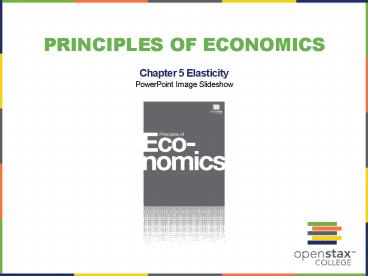Physics - PowerPoint PPT Presentation
1 / 12
Title:
Physics
Description:
... FIGURE 5.2 The price elasticity of demand is calculated as the percentage change in ... FIGURE 5.6 A demand curve with constant unitary elasticity will be a ... – PowerPoint PPT presentation
Number of Views:43
Avg rating:3.0/5.0
Title: Physics
1
Principles of Economics Chapter 5
Elasticity PowerPoint Image Slideshow
2
Figure 5.1
- Netflix, Inc. is an American provider of
on-demand Internet streaming media to many
countries around the world, including the United
States, and of flat rate DVD-by-mail in the
United States. (Credit modification of work by
Traci Lawson/Flickr Creative Commons)
3
Figure 5.2
- The price elasticity of demand is calculated as
the percentage change in quantity divided by the
percentage change in price.
4
Figure 5.3
- The price elasticity of supply is calculated as
the percentage change in quantity divided by the
percentage change in price.
5
Figure 5.4
- The horizontal lines show that an infinite
quantity will be demanded or supplied at a
specific price. This illustrates the cases of a
perfectly (or infinitely) elastic demand curve
and supply curve. The quantity supplied or
demanded is extremely responsive to price
changes, moving from zero for prices close to P
to infinite when price reach P.
6
Figure 5.5
- The vertical supply curve and vertical demand
curve show that there will be zero percentage
change in quantity (a) supplied or (b) demanded,
regardless of the price. This illustrates the
case of zero elasticity (or perfect
inelasticity). The quantity supplied or demanded
is not responsive to price changes.
7
Figure 5.6
- A demand curve with constant unitary elasticity
will be a curved line. Notice how price and
quantity demanded change by an identical amount
in each step down the demand curve.
8
Figure 5.7
- A constant unitary elasticity supply curve is a
straight line reaching up from the origin.
Between each point, the percentage increase in
quantity demanded is the same as the percentage
increase in price.
9
Figure 5.8
- Cost-saving gains cause supply to shift out to
the right from S0 to S1 that is, at any given
price, firms will be willing to supply a greater
quantity. If demand is inelastic, as in (a), the
result of this cost-saving technological
improvement will be substantially lower prices.
If demand is elastic, as in (b), the result will
be only slightly lower prices. Consumers benefit
in either case, from a greater quantity at a
lower price, but the benefit is greater when
demand is inelastic, as in (a).
10
Figure 5.9
- Higher costs, like a higher tax on cigarette
companies for the example given in the text, lead
supply to shift to the left. This shift is
identical in (a) and (b). However, in (a), where
demand is inelastic, the cost increase can
largely be passed along to consumers in the form
of higher prices, without much of a decline in
equilibrium quantity. In (b), demand is elastic,
so the shift in supply results primarily in a
lower equilibrium quantity. Consumers suffer in
either case, but in (a), they suffer from paying
a higher price for the same quantity, while in
(b), they suffer from buying a lower quantity
(and presumably needing to shift their
consumption elsewhere).
11
Figure 5.10
- An excise tax introduces a wedge between the
price paid by consumers (Pc) and the price
received by producers (Pp). - When the demand is more elastic than supply, the
tax incidence on consumers Pc Pe is lower than
the tax incidence on producers Pe Pp. - When the supply is more elastic than demand, the
tax incidence on consumers Pc Pe is larger than
the tax incidence on producers Pe Pp. The more
elastic the demand and supply curves are, the
lower the tax revenue.
12
Figure 5.11
- The intersection (E0) between demand curve D and
supply curve S0 is the same in both (a) and (b).
The shift of supply to the left from S0 to S1 is
identical in both (a) and (b). The new
equilibrium (E1) has a higher price and a lower
quantity than the original equilibrium (E0) in
both (a) and (b). However, the shape of the
demand curve D is different in (a) and (b). As a
result, the shift in supply can result either in
a new equilibrium with a much higher price and an
only slightly smaller quantity, as in (a), or in
a new equilibrium with only a small increase in
price and a relatively larger reduction in
quantity, as in (b).









![L 34 Modern Physics [1] PowerPoint PPT Presentation](https://s3.amazonaws.com/images.powershow.com/7125701.th0.jpg?_=20150905079)



![L 33 Modern Physics [1] PowerPoint PPT Presentation](https://s3.amazonaws.com/images.powershow.com/7602675.th0.jpg?_=201602121011)

















